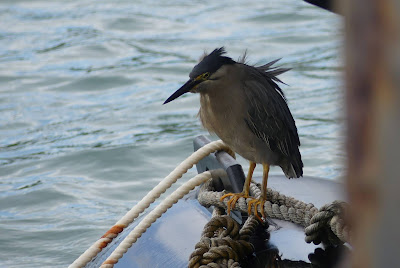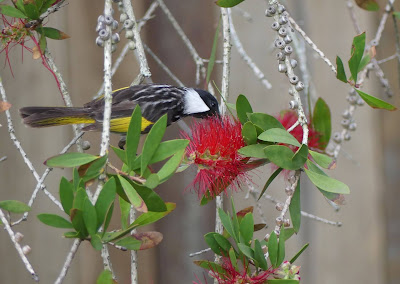Rising on the final morning of this visit with a sense that the time had passed quickly and "wish it had been longer" are good signs that the break had been a good one. The sense of "back to it", whatever that holds is very different to waking up to "OK let the day begin and unfold as it turns out". Far less sense that things are there "to be done" ... but enough of that ... this is about birds.
How could we farewell our abode without another pose by a little wattlebird in the banksia?
Also in the front garden I spied this grey shrike thrush battering some prey so it was tender enough to devour.
Last sighting at the house was while we were doing a final walk around making sure we had not forgotten anything. This buff-banded rail having a bit of a flap in the early morning dappled sunlight beside the sandy path leading over the dune to the beach - sunny and far less windy for the moment.
Like the little wattlebird, we could not head off without another visit to the river mouth to check on the tawny frogmouth ... perhaps it was the sun, but it had reversed its position on the nest but that little altered the superb camouflage!
I had to include this panorama because it has a whole different perspective in the wonderful clear mid-morning sunshine at low tide. The waterfall was still pumping out the cliff-face through its twin barrels.
A few beach birds were willing subjects as well. A lone pied oystercatcher reposing on the damp sand soaking up the sun from two different angles. In between is the ubiquitous blue-faced honeyeater perched high in a banksia enjoying the view across a clear sunny sky.
On the same stretch of sand exposed on the low tide, I was amused by the antics of this masked lapwing. The first photo just after it emerged from behind the boulder to the right of the shot ... seems to be in full prance mode of a runway model commanding "look at me, look at me" 😊. The second photo shows a more cautious side as it was working its way around me (actually quite something in nature as a human to be the creature standing still and watching!!).


Heading back to the car to leave, a few final Wooli sightings. Two below of a noisy friarbird, one distant and one mcuh more obliging close-up. There is a pied butcherbird perched on high looking resplendent cloaked in its tuxedo, among the dead branches and lush foliage of a banksia with the brilliant blue sky as background. While we were walking back in along the wall I had noticed what I thought (hoped?!) was an eastern curlew (with that wonderfully long curved bill) take flight up the beach and swing around and descend below the trees towards the river ... so it turned out; so a final Wooli treat to see this rare species grazing on the sand flats across the river.




We decided we would call in and grab a coffee at Minnie Water on the way. I had called in there on my previous visit and on such a morning I suggested the headland lookout would be a great spot to drink our coffee. We even caught sight of a few whales wallowing in quite close to shore. Nearby was a sign for a local Dune Care Group trail and we decided to head along for a bit to reach a viewing spot and look back along the beach southwards to Diggers Camp and Wooli (and getting good vision of North Solitary Islands too).
It was a beautifully maintained track and the nor'easter breeze through the trees kept the rising temperature down. The dappled sunlight was a treat as well after all the rain during our visit. Not far along the track we spied a sand goanna ... fotunately it did an about turn and headed back to the left of the photo into the bush (very quietly I might add). Then I spied a rainbow bee-eater, finally in the sunlight, doing justice to its lustrous sheen and radiant palette 😊.


We then passed a couple heading back to the car park who told us of a close encounter with some "black cockatoos" not too much further along the track. We proceeded for quite some way and almost gave up, but with our final foray forward we heard them in the trees close by. A small flock, we counted eight. They let us know of their awareness of our presence, but were patient enough for us to mange some good shots through the trees of pairs and a couple of singles. I was especailly pleased to have this opportunity because one morning I drove down in the rain to get a coffee and saw (this flock?) some in a banksia near the Bowling Club. I did not have my camera as it was raining. When we went for a walk that afternoon, they were still in the trees, and that was where I had ventured (unsuccessfully) when I took the photo in an earlier post of the plover parent and youngster. Tromping across the open park (even carefully) spooked the cockatoos and perhaps the alarm calls of the plover worked on them as well? So, to be able to get these shots of the magnificent yellow-tailed black cockatoos feeding among the banksia and casuarina was another of those unexpected but wonderful treats.





Finally back at the car park and two final reminders of the wonderful colours and settings we have at our fingertips when we notice our unique birdlife ... a rainbow bee-eater and white-cheeked honeyeater perched in different positons in different banksias. The bee-eater perched in a position to lookout for flying feasts, while the honeyeater is content to savour the nectar of the flowers in the gorgeous silver/green foliage.
Then we headed home ...
Thanks for taking some time to share our journey to and sojourn in Wooli. I would commend a visit BUT selfishly want to refrain from any promotion in the hope of prolonging the isolation and unspoiled environment that for the moment persists - of course, that is a trite wish because merely writing it in a public blog like this provides the promotion, but I imagine you get the sentiment 😛.
We decided on our return to compose a coffee table photobook for our hosts and chose a hoto of the range of birds I have catalogued after these recent visits to Wooli - 35 in all (I only included 34 in the book because one remained unidentified until just recently). My enduring memory of this visit and these last several posts is definitately that birdlife abounds irrespective of the weather - it (the weather) simply provides a wide range of backgrounds and settings and environments facilitating an equally wide range of bird behaviours as they cope.
My privileged journey moves on ...


























































